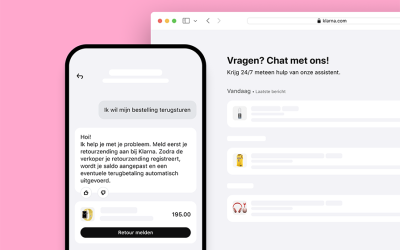Ballast Nedam: Wanting to do better tomorrow than today
Ballast Nedam Materieel had a problem making construction equipment quickly available again after a project. After the goods were turned in, it took about 3 weeks before everything was available again and could be re-rented. This involves high costs. The whole process has been reduced to 48 hours. And it still is. We hire less equipment than before and we do the same work with fewer people, saving a lot of money.
Ballast Nedam is a medium-sized construction company, currently working mainly in the Netherlands. The equipment company facilitates the construction business in the Netherlands and in the Caribbean. This entails Ballast Nedam Materieel setting up the construction site, in terms of housing (the construction huts) and in terms of electrics, renting out the tools and everything else needed in a construction operation, from hand saws to tower cranes.

“The project only really gained traction because people saw that something was happening.”
Sipke Kooistra – Ballast Nedam Materieel
We spoke with Sipke Kooistra, operations manager at Ballast Nedam Materieel. “I wanted to address the logistics. In my experience, this process was taking far too long. Just to get a good view of your logistics processes, you have to clean up the tent first. So we used Lean and 5S for that. Once everyone knew the principles and was enthusiastic enough about them, we said let’s map out that logistics project as well.”
High costs due to inefficient logistics
“All the equipment we rented out that comes back has to be checked and cleaned. As a result, we had a constant stock on hand for about three weeks. In other words, it took three weeks before we knew what was short and what the damage was and we could finally have the final bill take place. So we often sent an unjustified bill first, which we had to credit again. In addition, we did not have access to the materials during this period. So we had to hire again. In short, in my opinion there was a lot to be gained by putting such a logistical operation in order.”
“It took me a while to get my colleagues to join in. Many of them have been working here the same way for 18 years. I came as a newcomer and I established that there is a three-week backlog and that this backlog remains constantly three weeks. So it seemed to me that this backlog should be eliminated like hell. Surely that should give us a lot. If everybody cooperates then we will succeed. If nobody cooperates, I’ll never get it right.”
“So we had a constant three-week backlog. Now everything is completed within 48 hours. To achieve this, we looked at the processes in particular. It turned out that the material that was returned was parked in a warehouse where the truck was unloaded. Then days and sometimes weeks passed before the products were repaired, cleaned and back in place and visible in the system as available again. First it was agreed that everything that came back during unloading would be checked immediately. What is good is immediately returned to its proper place and made available again immediately. The rest goes to repair or cleaning.”
A positive approach
“Initially there was enormous resistance. Until the moment I had enough examples showing that the whole process was costing us a lot of money. I managed to make it clear that this is a waste that is of no use to anyone. Once they understood that, they were willing to cooperate. And certainly in the way we handled it. In the end, the people did it themselves and were responsible for the result. They improved the process and the quality. So as a result, now everything is handled within 48 hours instead of three weeks. Moreover, we can now achieve more with fewer people. So an end result above expectations.”
“To get to this result did require a change of gear. We called the people together and in several sessions we stuck together and mapped out the processes. People often tend to defend what they do. So we talked exclusively about how things should actually be done, including in the most positive sense. Then we created flowcharts, always assuming the most ideal situation. Every person involved had to work on always having an ideal situation. We want to push boxes. We are a rental company. And in logistics, the schedule also has to be clear. For the forklift driver, for example, it has to be visible that something is ready so he can grab it.”
“So we created and modified a Value Stream Map (VSM) until we had the whole stream mapped out. That took us parts of the day. But everyone was enthusiastic. Each time we involved colleagues from other disciplines. Until we had exactly mapped out how a part goes through the organization. So until we had our processes clear.”
“In total, about 15 people collaborated on the project. These were people from different disciplines, but all related to the process. The heads of the departments and the two operations managers, one of whom is me, were part of the team. One of our colleagues, from engineering and innovation, was project leader and pulled the project together with Symbol’s supervisor and coach. That is, Symbol only coached us, otherwise we did everything ourselves. The project leader created the flowcharts and monitored them.”
Even the most skeptical person is proud of the result
“The project only really gained traction because people saw that something was happening. Seeing is believing. Understanding and doing. Then you can quickly achieve something. With Value Stream Mapping, but also by communicating, by calling people together, telling them what it costs. As managers, we must also believe in this ourselves. You use Lean principles and 5S as a means, not an end: “We are going Lean”. No, our goals are to reduce costs and create a piece of appearance and a pleasant and safe working environment. I don’t have to explain to anyone that it costs money and is unpleasant and unsafe to have to search for stuff in junk.”
“People experience this as a burden at first. But in the end, I have never seen my colleagues make so many rounds with guests. We have things pretty much in hand by now. Big suppliers of ours, who also do logistics handling and rental and who are shown around our place, are impressed with how we’ve done it. Everyone is proud of that.”
“We have been able to maintain handling at 48 hours. It costs much less money now than before and we do it with fewer people. We have a flexible shell. If we know more is being disposed of, we hire more people. And if there is less draining, we send people home. We also notify the sender of the damage right away. It’s still “hot” then. And even in that we have continued through budget calculations, a dent costs this and a scratch costs that.”
“Lean Six Sigma (LSS) is now part of our strategy. The Board of Directors of Ballast Nedam visited us last summer. And they noticed that we are a tightly organized organization. We take that as a compliment.”
We continue
“Symbol is now guiding us in the next phase, which is to create a new company handbook. But we are making that book ourselves. And we’re not doing it because we have to, but because we want to get the company even better under control. Working safely is more than complying with all the protocols, but then finding all the measures too expensive and, when necessary, simply working unsafely again. By the way, we do have all the certificates in place. People who say that safety costs money don’t quite get it. Within Ballast Nedam we pay 20 million a year just on the consequences of working unsafely. So don’t go telling people within our organization that the cost of working safely is too high. Moreover, our administrative apparatus needs a lot of work. We want to address that, too, based on LSS principles, by mapping the value stream in the same way we have done for our logistics processes.”
Reflecting and sharing
“In the end, what matters is that someone else helps you find a mirror. You have to hold a mirror up to yourself, because you know it all. Even the least educated can see what he is doing wrong. It is not a college at all. But it is terribly difficult to actually start. Clean up. Making choices. What do you need. We closed a few branches and three households came together. There are lifting tools here, eight jacks. Of those, five are leaving. Sin? Yes of course! But we no longer have a work space, we stumble over it, we have to inspect it every year, clean it up, we have to pass those things through our hands ten times a year. New parts for machines we no longer have go straight into the scrap metal container. You learn from it that you have to stockpile very limited supplies. So more thinking. That’s the most important thing. Thinking about your own and your colleagues’ work, thinking about what you do. I found that mirror. And I look into it every night. Then I wonder if I made sense today.
And whether maybe I can do better tomorrow than today. But to do better tomorrow you will have to delve into today’s issues. It is important to stay engaged with your people. About anything. About what a repair cost, what a new machine cost, what we earned together. Every conversation, every training, you learn something from that. People become more enthusiastic and smart about it. They won’t have to buy a new machine next week. It’s not about that, but they know what it’s about.”
Latest news/blogs
Klarna saved 40 million with AI but lost the trust of its customers
Klarna saved40million with AI but lost the trust of its customersThe question sounds absurd: how...
How do you eat an elephant?
Dutch productivity is falling again - and that offers precisely opportunitiesLabor productivity in...
From Theory to Practice: Junior Consultant at Stoneridge
From theory to practice: Junior Consultant at Stoneridge Before working at Symbol, Junior...


